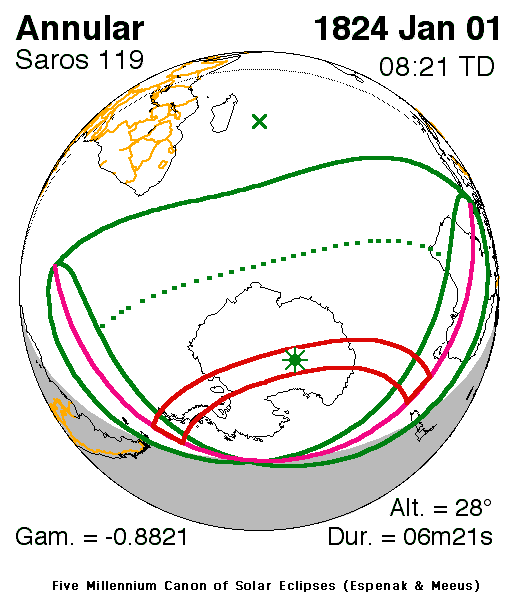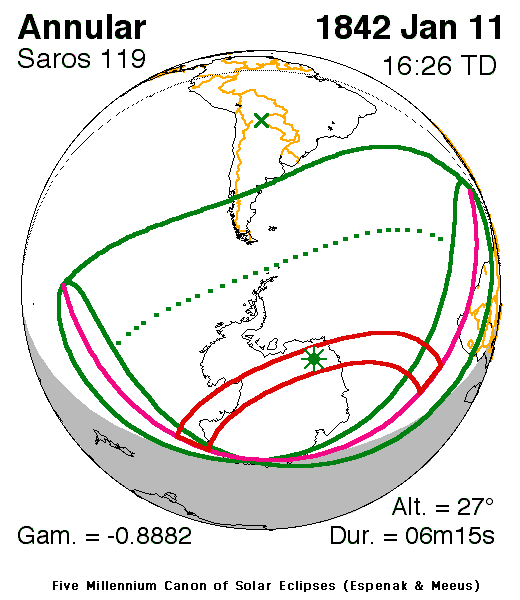|
Solar Eclipse Of April 19, 2004
A partial solar eclipse took place on 19 April 2004. A solar eclipse occurs when the Moon passes between Earth and the Sun, thereby totally or partly obscuring the image of the Sun for a viewer on Earth. A partial solar eclipse occurs in the polar regions of the Earth when the center of the Moon's shadow misses the Earth. It was largely visible over the south Atlantic Ocean and north shores of Antarctica, most prominently the Antarctic Peninsula. The eclipse could also be seen in southern Africa at sunset. Considering the magnitude and the solar altitude, South Africa was the best place to observe this eclipse. In Cape Town, the sun was about 40% obscured, while in Pretoria the sun was 29% obscured. Further north, the eclipse remained visible up to Angola, southern DR Congo and Tanzania. Images Animated eclipse path Related eclipses Eclipse season An eclipse season is the period, roughly every six months, when eclipses occur. Eclipse seasons are the result of the axi ... [...More Info...] [...Related Items...] OR: [Wikipedia] [Google] [Baidu] |
Solar Eclipse
A solar eclipse occurs when the Moon passes between Earth and the Sun, thereby obscuring the view of the Sun from a small part of the Earth, totally or partially. Such an alignment occurs during an eclipse season, approximately every six months, during the new moon phase, when the Moon's orbital plane is closest to the plane of the Earth's orbit. In a total eclipse, the disk of the Sun is fully obscured by the Moon. In partial and annular eclipses, only part of the Sun is obscured. Unlike a lunar eclipse, which may be viewed from anywhere on the night side of Earth, a solar eclipse can only be viewed from a relatively small area of the world. As such, although total solar eclipses occur somewhere on Earth every 18 months on average, they recur at any given place only once every 360 to 410 years. If the Moon were in a perfectly circular orbit and in the same orbital plane as Earth, there would be total solar eclipses once a month, at every new moon. Instead, because the Moon ... [...More Info...] [...Related Items...] OR: [Wikipedia] [Google] [Baidu] |
Solar Eclipse Of October 14, 2004
A partial solar eclipse occurred on October 13–14, 2004. A solar eclipse occurs when the Moon passes between Earth and the Sun, thereby totally or partly obscuring the image of the Sun for a viewer on Earth. A partial solar eclipse occurs in the polar regions of the Earth when the center of the Moon's shadow misses the Earth. It was the 54th eclipse of the 124th Saros cycle, which began with a partial eclipse on March 6, 1049 and will conclude with a partial eclipse on May 11, 2347. Images Animated path Related eclipses Eclipse season This is the first eclipse this season. Second eclipse this season: 28 October 2004 Total Lunar Eclipse Eclipses of 2004 * A partial solar eclipse on April 19. * A total lunar eclipse on May 4. * A partial solar eclipse on October 14. * A total lunar eclipse on October 28. Saros 124 Solar eclipses 2004–2007 Metonic series References External links * http://eclipse.gsfc.nasa.gov/SEplot/SEplot2001/SE2004Oct14P.GIF *Google in ... [...More Info...] [...Related Items...] OR: [Wikipedia] [Google] [Baidu] |
Solar Eclipse Of March 18, 1950
An annular solar eclipse occurred on March 18, 1950. A solar eclipse occurs when the Moon passes between Earth and the Sun, thereby totally or partly obscuring the image of the Sun for a viewer on Earth. An annular solar eclipse occurs when the Moon's apparent diameter is smaller than the Sun's, blocking most of the Sun's light and causing the Sun to look like an annulus Annulus (or anulus) or annular indicates a ring- or donut-shaped area or structure. It may refer to: Human anatomy * ''Anulus fibrosus disci intervertebralis'', spinal structure * Annulus of Zinn, a.k.a. annular tendon or ''anulus tendineus com ... (ring). An annular eclipse appears as a partial eclipse over a region of the Earth thousands of kilometres wide. While it was an annular solar eclipse, it was a ''non-central'' solar eclipse (when the gamma is 0.9972 or larger). Related eclipses Solar eclipses of 1950–1953 Saros 119 It is a part of Saros cycle 119, repeating every 18 years, 11 days, ... [...More Info...] [...Related Items...] OR: [Wikipedia] [Google] [Baidu] |
Solar Eclipse Of March 7, 1932
An annular solar eclipse occurred on March 7, 1932. A solar eclipse occurs when the Moon passes between Earth and the Sun, thereby totally or partly obscuring the image of the Sun for a viewer on Earth. An annular solar eclipse occurs when the Moon's apparent diameter is smaller than the Sun's, blocking most of the Sun's light and causing the Sun to look like an annulus Annulus (or anulus) or annular indicates a ring- or donut-shaped area or structure. It may refer to: Human anatomy * ''Anulus fibrosus disci intervertebralis'', spinal structure * Annulus of Zinn, a.k.a. annular tendon or ''anulus tendineus com ... (ring). An annular eclipse appears as a partial eclipse over a region of the Earth thousands of kilometres wide. Related eclipses Solar eclipses 1931–1935 Saros 119 It is a part of Saros cycle 119, repeating every 18 years, 11 days, containing 71 events. The series started with partial solar eclipse on May 15, 850 AD. It contains total eclipses on Augu ... [...More Info...] [...Related Items...] OR: [Wikipedia] [Google] [Baidu] |
Solar Eclipse Of February 25, 1914
An annular solar eclipse occurred on February 25, 1914. A solar eclipse occurs when the Moon passes between Earth and the Sun, thereby totally or partly obscuring the image of the Sun for a viewer on Earth. An annular solar eclipse occurs when the Moon's apparent diameter The angular diameter, angular size, apparent diameter, or apparent size is an angular distance describing how large a sphere or circle appears from a given point of view. In the vision sciences, it is called the visual angle, and in optics, it is ... is smaller than the Sun's, blocking most of the Sun's light and causing the Sun to look like an annulus (ring). An annular eclipse appears as a partial eclipse over a region of the Earth thousands of kilometres wide. Related eclipses Solar eclipses of 1913–1917 Saros 119 It is a part of Saros cycle 119, repeating every 18 years, 11 days, containing 71 events. The series started with partial solar eclipse on May 15, 850 AD. It contains total eclipses o ... [...More Info...] [...Related Items...] OR: [Wikipedia] [Google] [Baidu] |
SE1824Jan01A
The SE (South Eastern) postcode area covers a broad radial swathe of the south-east of the London post town from the Albert Embankment to West Heath and the nearest edges of Sidcup and Selhurst. It loosely corresponds to the boroughs of Southwark, Lewisham and Greenwich plus indicated parts of the boroughs of Croydon (north), Lambeth (east), Bexley (west) and Bromley (its northwest corner). Postal administration The postcode area originated in 1857 as the SE district. In 1868 it gained some of the area of the short-lived S district, with the rest going to SW. It was divided into numbered districts in 1917, by giving the district closest to London that hosted the head office the suffix "1" and all others alphabetically based on a locally important parish, chapelry, topological or built environment feature administering or close to the local distribution office. SE28 is a late addition carved out of the existing districts SE2 and SE18 to reflect the building up of a new ... [...More Info...] [...Related Items...] OR: [Wikipedia] [Google] [Baidu] |



